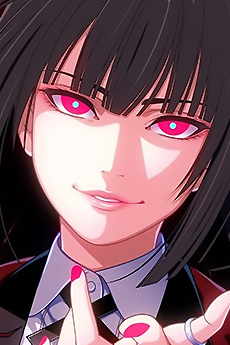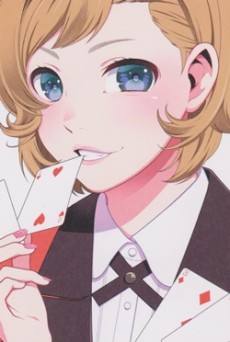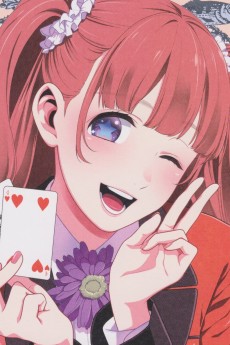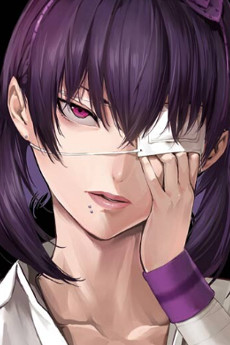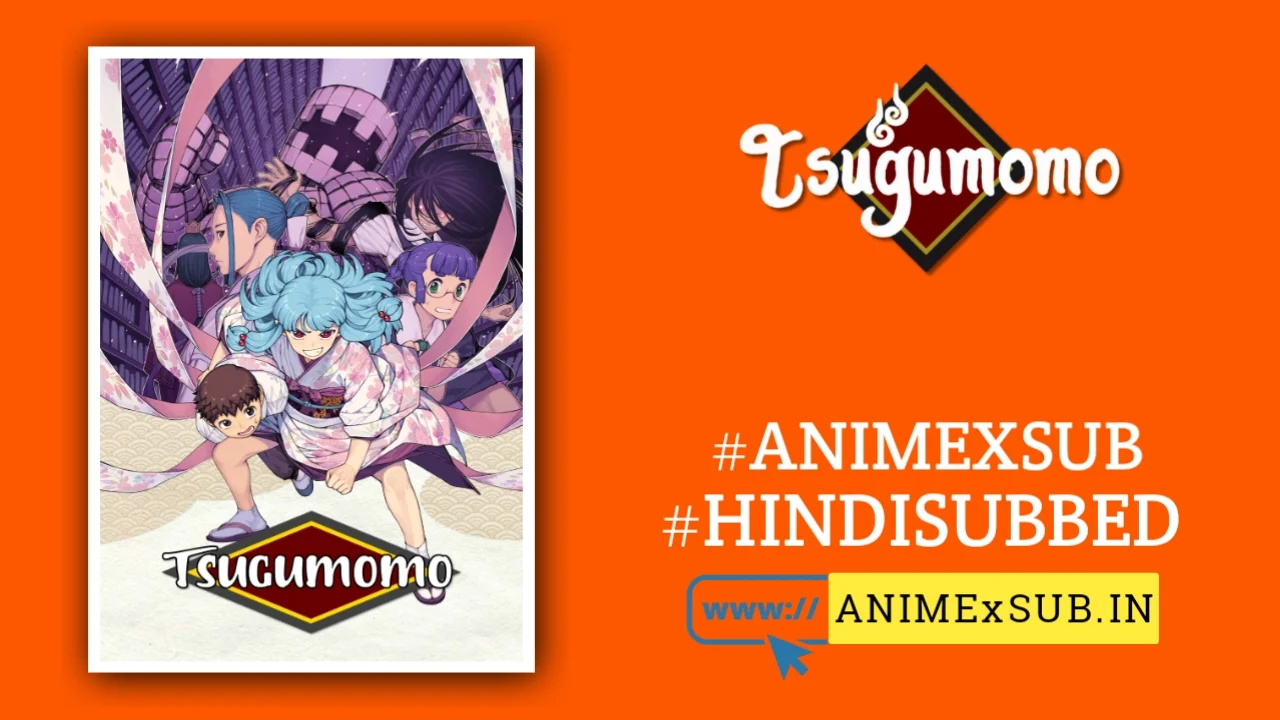
Kakegurui Season 1 Hindi Subbed [12/12] {Complete}

Kakegurui
KakeguruiSynopsis
During daylight hours, an exclusive, elite private school prepares its illustrious students for careers in business, politics, and high society. But when darkness falls, the halls of this esteemed establishment transform into an underground gambling den where bright-eyed youngsters learn the timeless art of bluffing, backdoor dealings and social manipulation. In this school for the rich and elite, money is power, and the tyrant of the betting books rules with an iron fist. So when the beautiful Yumeko Jabami upsets the academy hierarchy with her voracious appetite for the thrill of the gamble, the entire student body mobilizes to send her house of cards tumbling down. (Source: Sentai Filmworks)
Watch Trailer
Characters
Kakegurui Season 1: A Frenzied Descent into the Psychology of Risk
Kakegurui: Compulsive Gambler Season 1, a 12-episode anime that premiered in July 2017, is a kaleidoscopic plunge into a world where gambling isn’t just a pastime—it’s a brutal, high-stakes microcosm of power, obsession, and human nature. Adapted from Homura Kawamoto’s manga and brought to life by MAPPA’s vivid animation, the series is a psychological thriller that doesn’t just push boundaries; it obliterates them with a manic grin. This review dissects what makes Kakegurui a singular experience, exploring its thematic depth, stylistic audacity, and narrative gambles—while acknowledging where it occasionally overplays its hand.
The High-Stakes World of Hyakkaou Academy
At the heart of Kakegurui lies Hyakkaou Private Academy, a prestigious institution for Japan’s elite, where wealth and lineage mean nothing without the cunning to dominate at the gambling table. Here, students don’t study traditional academics; they hone their skills in games of chance and strategy, where winning elevates you to godlike status and losing reduces you to a “house pet,” stripped of dignity and autonomy. The school’s hierarchy is a ruthless allegory for capitalist systems, where power is fluid, and one bad bet can cost you everything.
Enter Yumeko Jabami, the enigmatic transfer student whose serene demeanor masks an insatiable gambling addiction. Voiced with chilling precision by Saori Hayami (and Erika Harlacher in the English dub), Yumeko is no ordinary protagonist. She’s a force of chaos, drawn not to money or status but to the raw thrill of risk itself. Her arrival disrupts Hyakkaou’s fragile ecosystem, setting her on a collision course with the omnipotent Student Council, led by the inscrutable President Kirari Momobami. Alongside Ryota Suzui, a timid house pet who becomes her reluctant ally, Yumeko challenges the council’s authority through a series of increasingly unhinged gambling matches.
A Visual and Auditory Fever Dream
Kakegurui’s aesthetic is its first ace. MAPPA’s animation is a psychedelic assault, blending vibrant colors with grotesque, exaggerated facial expressions that externalize the characters’ inner turmoil. When a character spirals into desperation or ecstasy, their eyes might glow with manic intensity or contort into nightmarish distortions—a visual shorthand for the psychological stakes of each bet. The show’s art direction, particularly its use of stark reds and purples, evokes a casino’s intoxicating haze, while close-ups on trembling hands or scattered cards amplify tension. This isn’t just animation; it’s a sensory overload that mirrors the characters’ own unraveling.
The soundtrack is equally audacious, weaving jazz, techno, and haunting piano into a hypnotic tapestry. Tracks like the opening theme, “Deal with the Devil” by Tia, pulse with a seductive menace that perfectly encapsulates the show’s tone. Sound design—shuffling cards, clattering chips, or the sharp intake of breath before a pivotal move—grounds the viewer in the tactile reality of each game, making every match feel visceral.
The Psychology of Gambling as Narrative Engine
What sets Kakegurui apart from other anime is its unflinching exploration of gambling as a lens for human behavior. Each game—whether it’s a modified rock-paper-scissors, a memory-based card match, or a sadistic Russian roulette variant—is a psychological battleground. The series doesn’t just depict gambling; it dissects the motivations behind it: greed, pride, desperation, or, in Yumeko’s case, pure compulsion. Her addiction is portrayed not as a flaw to overcome but as a defining trait, making her both magnetic and terrifying. She’s less a hero than an agent of anarchy, exposing the flaws of Hyakkaou’s system and its players.
The show’s strength lies in how it uses these games to reveal character. Opponents like Mary Saotome, a cunning blonde with a chip on her shoulder, or Midari Ikishima, a masochistic council member obsessed with death, are defined by their strategies and reactions under pressure. For instance, Mary’s initial cruelty gives way to grudging respect for Yumeko, while Midari’s unhinged bets push the narrative into darker territory. Yet, the series doesn’t fully develop these characters beyond their gambling personas, leaving their backstories and motivations frustratingly vague. This lack of depth can make some matches feel like spectacles rather than emotional turning points.
Thematically, Kakegurui gestures toward critiques of wealth, power, and addiction but doesn’t always follow through. The absence of adults in the narrative—no teachers or parents question Hyakkaou’s dystopian system—feels like a missed opportunity to ground the stakes in a broader societal context. Similarly, the show hints at the consequences of gambling (debt, servitude, psychological ruin) but rarely lets Yumeko face lasting repercussions, which can undermine the tension. Her invincibility, while thrilling, sometimes makes outcomes feel predetermined.
Narrative Structure: A Double-Edged Sword
The 12-episode arc follows a predictable rhythm: Yumeko faces a new opponent, outwits them through a mix of skill and audacity, and moves closer to confronting Kirari. While the variety of games keeps things fresh, the formula can feel repetitive by the later episodes. The pacing, too, is relentless—each match escalates quickly, leaving little room for quieter moments or character development outside the gambling table. This breakneck speed suits the show’s chaotic energy but sacrifices nuance, particularly for supporting characters like Ryota, who remains a passive observer despite his potential as a moral anchor.
Yet, the series’ climax—a high-stakes showdown with Kirari—delivers a masterclass in tension, blending strategy, betrayal, and raw emotion. It’s a testament to Kakegurui’s ability to make even familiar tropes feel electrifying. The finale sets up intriguing possibilities for Season 2, hinting at deeper layers to Kirari’s motives and Yumeko’s obsession, though it stops short of fully resolving the central conflict.
Unique Strengths and Missed Opportunities
Kakegurui excels in its audacity. It takes a niche concept—gambling as a school curriculum—and spins it into a feverish exploration of human nature. The show’s refusal to sanitize its characters’ flaws or sugarcoat their motivations makes it a refreshing departure from more conventional anime. Yumeko, in particular, is a standout: her gleeful descent into madness during a high-stakes bet is both captivating and unsettling, redefining what a protagonist can be.
However, the series isn’t flawless. Its overreliance on shock value—exaggerated expressions, sexualized imagery, or Midari’s masochistic antics—can feel gratuitous, especially early on. While the tone shifts darker as the season progresses, these elements risk alienating viewers who might otherwise be drawn to the psychological depth. Additionally, the lack of context for Hyakkaou’s bizarre system (why do parents allow this? how do students have such wealth?) requires a suspension of disbelief that not all viewers will grant.
A Cultural Lens: Why It Resonates
Kakegurui taps into universal themes—risk, power, and the allure of control—while reflecting Japan’s complex relationship with gambling. In a country where gambling is heavily regulated yet culturally fascination (think pachinko parlors), the show’s exaggerated premise feels like a satirical jab at systems that reward cunning over ethics. Yumeko’s addiction, meanwhile, mirrors real-world compulsive behaviors, though the show stops short of moralizing, letting viewers draw their own conclusions. This ambiguity is both a strength and a limitation, inviting interpretation but risking shallowness.
The Verdict: A Wild Bet Worth Taking
Kakegurui Season 1 is a thrilling, flawed gem that dares to be different. Its visual and auditory brilliance, combined with its unflinching portrayal of obsession, makes it a standout in the psychological thriller genre. While it stumbles with repetitive pacing and underdeveloped characters, its commitment to its unhinged vision is undeniable. For viewers willing to embrace its chaos, it’s a rollercoaster of suspense and style that leaves you hungry for the next bet.
Rating: 7.5/10 – A bold, visually stunning ride that occasionally overplays its hand but never fails to captivate.
Support Our Anime Community!
Love watching the latest anime? Help us keep uploading new episodes by join telegram channel ❤️
Join Now!